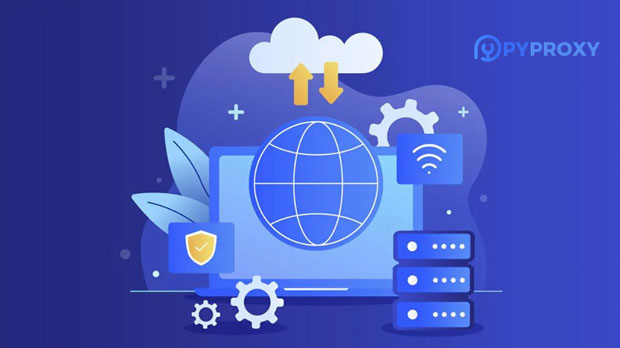The global deployment of static proxies has become a fundamental aspect of modern network security and data management strategies. As businesses and organizations look to safeguard sensitive data while ensuring seamless access to services worldwide, static proxies offer a reliable and efficient solution. PYPROXY, a leading static proxy package, brings forward a range of strategic benefits in this context. This article delves into the various dimensions of PYPROXY's role in the global static proxy landscape, emphasizing its practical value and long-term impact on organizational growth. Introduction to Static Proxy TechnologyBefore diving into the strategic advantages of PYPROXY, it's essential to understand the concept of static proxies. Static proxies are intermediaries that act as secure gatekeepers between users and the internet. Unlike dynamic proxies that rotate IP addresses, static proxies maintain a consistent IP, offering reliable access and a stable connection for prolonged use. This stability is crucial for activities requiring high levels of anonymity, consistent traffic routing, and secure data transfer, making static proxies invaluable in a variety of sectors such as e-commerce, cybersecurity, digital marketing, and data scraping.Global Static Proxy Deployment: A Growing NecessityWith the increasing globalization of businesses, companies are expanding their digital presence across different regions, each with its own set of regulations, internet infrastructure, and user behavior patterns. A global network strategy is required to support these diverse requirements. Static proxies allow businesses to effectively route their traffic through different geographical locations, ensuring that they comply with regional data protection laws and reach their audience without restrictions.For instance, businesses operating across multiple countries can use static proxies to enhance their localization efforts, ensuring consistent user experiences by simulating local traffic. Moreover, static proxies are indispensable for enhancing privacy and security, especially when dealing with sensitive customer information or confidential business data.Strategic Value of PYPROXY Static Proxy PackageThe PYPROXY static proxy package stands out in the competitive landscape for several reasons. Its architecture and features align perfectly with the needs of businesses looking to optimize their proxy deployment strategy. Let’s explore some of the key strategic values of PYPROXY.1. Robust Security FeaturesSecurity is paramount in any network infrastructure, and PYPROXY ensures that businesses can rely on secure connections. Its static IP addresses not only prevent unauthorized access but also allow users to perform activities like data scraping or accessing geo-restricted content without compromising security. The package integrates with advanced encryption technologies, further enhancing the safety of sensitive data and protecting against data breaches or cyberattacks.2. Performance OptimizationThe performance of static proxies is a critical factor for businesses engaged in high-traffic applications. PYPROXY offers superior network performance, ensuring high-speed and low-latency connections. Whether it's for digital marketing campaigns, web scraping, or load testing, PYPROXY optimizes data flow, reducing delays and enhancing overall productivity. This ensures that businesses can scale their operations while maintaining top-tier user experiences.3. Cost-EffectivenessWhile static proxies are often considered more expensive compared to dynamic alternatives, PYPROXY provides a cost-effective solution by offering competitive pricing without compromising on quality. Businesses that require stable, long-term proxy connections can benefit from PYPROXY’s pricing structure, which allows for predictable costs over time. This is particularly advantageous for enterprises that depend on large-scale data operations or have consistent proxy usage needs.4. Customizable Proxy SolutionsOne of the most compelling features of PYPROXY is its ability to provide tailored proxy solutions. Companies operating in different industries have unique requirements that can vary in terms of geography, traffic type, and application. PYPROXY allows businesses to configure their proxy package based on these specific needs, offering flexibility in deployment and ensuring the best possible fit for the company’s objectives.5. Global Coverage and ScalabilityPYPROXY’s global infrastructure ensures businesses can access proxies across a wide range of geographical locations, allowing for seamless operations in different regions. This global coverage is particularly beneficial for multinational companies that require proxies in multiple countries to simulate local traffic and comply with regional laws. Additionally, PYPROXY’s scalability ensures that organizations can expand their proxy usage as they grow, making it a long-term solution for businesses with evolving needs.6. Enhanced Anonymity and PrivacyAnonymity and privacy are critical concerns for users and organizations alike. PYPROXY ensures that businesses can maintain complete anonymity while conducting operations online. With a static proxy, businesses can avoid the risk of detection or tracking, providing an additional layer of protection for their operations. This is particularly valuable for industries such as market research, where the ability to scrape data from websites without leaving traces is essential.7. Simplified Management and IntegrationManaging large-scale proxy deployments can be complex and time-consuming. PYPROXY simplifies the management process with its user-friendly interface and integration capabilities. The package is compatible with a wide range of applications, from e-commerce websites to cybersecurity tools, ensuring that businesses can easily integrate PYPROXY into their existing systems. Furthermore, its intuitive interface allows for quick configuration and monitoring, reducing the need for specialized technical expertise.Practical Applications of PYPROXY in Various IndustriesThe strategic advantages offered by PYPROXY make it a versatile solution across numerous industries. Some of the most notable applications include:1. E-Commerce and Digital MarketingIn the e-commerce industry, maintaining accurate pricing data, competitor analysis, and customer insights is crucial. PYPROXY enables businesses to gather real-time data from multiple sources without being blocked or flagged by websites, offering them a competitive edge in digital marketing and product optimization. Furthermore, static proxies help businesses deliver personalized user experiences by simulating local traffic in different regions.2. Web ScrapingFor businesses involved in web scraping, whether for lead generation, market research, or competitor analysis, PYPROXY provides a robust solution. The static nature of the proxy ensures that scraping activities are not interrupted, even when large volumes of data are being accessed. Additionally, the global coverage allows businesses to gather data from various regions without geographical restrictions.3. Cybersecurity and Fraud PreventionStatic proxies are also an essential tool for cybersecurity teams looking to detect and prevent fraud or cyberattacks. By using PYPROXY, organizations can monitor user activities, detect anomalies, and protect their infrastructure from malicious attacks. Static proxies also provide an additional layer of defense by masking users’ real IP addresses, making it difficult for hackers to track or target specific systems.4. Data Privacy ComplianceWith the increasing complexity of data protection regulations such as GDPR, businesses must take extra precautions to ensure compliance. PYPROXY’s secure proxy package ensures that organizations can operate within the boundaries of regional data laws while maintaining operational efficiency. By using proxies located in specific countries, companies can ensure that data does not cross borders without the appropriate permissions.Conclusion: The Future of PYPROXY in Global Proxy StrategiesAs the world becomes increasingly connected, the need for reliable, secure, and cost-effective proxy solutions will continue to grow. PYPROXY’s strategic value in the global static proxy market is undeniable, offering businesses the flexibility, security, and performance needed to thrive in a rapidly changing digital landscape. Its global coverage, scalability, and ability to integrate seamlessly with existing systems make it a powerful tool for businesses looking to optimize their proxy deployments.By adopting PYPROXY, companies can future-proof their operations, ensuring that they stay ahead of the competition while maintaining the highest standards of security, privacy, and performance. In an era of digital transformation, PYPROXY is more than just a static proxy package—it is a strategic enabler for businesses looking to expand and succeed in the global market.
Nov 13, 2025



































































